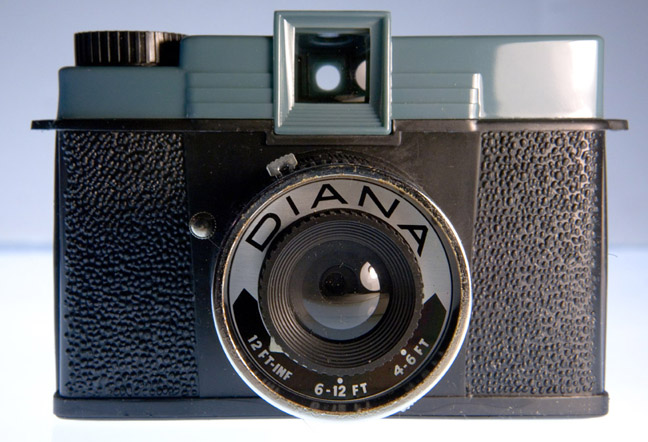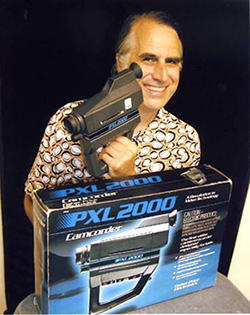|
Toy Camera
A toy camera is a simple, inexpensive film camera. Despite the name, toy cameras are fully functional and capable of taking photographs, though with optical aberrations due to the limitations of their simple lenses. From the 1960s onward, there has been interest in the artistic use of such cameras or recreation of this style, both with cameras originally designed for children, and others originally intended as mass-market consumer cameras. Many professional photographers have used toy cameras and exploited the vignetting, blur, light leaks, and other distortions of their inexpensive lenses for artistic effect to take award-winning pictures. Toy camera photography has been widely exhibited at many popular art shows, such as the annual "Krappy Kamera" show at the Soho Photo Gallery in the Tribeca neighborhood of New York City. Various publications such as ''Popular Photography'' magazine have extolled the virtues of the Diana camera in its own right as an "art" producing imag ... [...More Info...] [...Related Items...] OR: [Wikipedia] [Google] [Baidu] |
Diana Camera
The Diana camera is a plastic-bodied toy camera that uses 120 roll film and 35 mm film. The camera has a simple plastic meniscus lens. Originally marketed as an inexpensive novelty gift item, the Diana has been used to take soft focus, impressionistic photographs somewhat reminiscent of the Pictorialist Period of artistic photography, branded in contemporary times as Lomography. The Diana frequently suffers from light leaks, film advance issues, and other problems. However, its low-quality plastic lens has been celebrated for its artistic effects in photographs, normally resulting in a slightly blurred composition that can provide a 'dreamlike' quality to the print. History The Diana first appeared during the early 1960s as an inexpensive box camera sold by the ''Great Wall Plastic Factory'' of Kowloon, Hong Kong.Featherstone, p. 5 Most were exported to the United States and the United Kingdom. In the United States, the Diana was imported by the ''Power Sales Company'' of Wil ... [...More Info...] [...Related Items...] OR: [Wikipedia] [Google] [Baidu] |
Diana (camera)
The Diana camera is a plastic-bodied toy camera that uses 120 film, 120 roll film and 135 film, 35 mm film. The camera has a simple plastic meniscus lens. Originally marketed as an inexpensive novelty gift item, the Diana has been used to take soft focus, Impressionism, impressionistic photographs somewhat reminiscent of the Pictorialist Period of artistic photography, branded in contemporary times as Lomography (company), Lomography. The Diana frequently suffers from light leaks, film advance issues, and other problems. However, its low-quality plastic lens has been celebrated for its artistic effects in photographs, normally resulting in a slightly blurred composition that can provide a 'dreamlike' quality to the print. History The Diana first appeared during the early 1960s as an inexpensive box camera sold by the ''Great Wall Plastic Factory'' of Kowloon, Hong Kong.Featherstone, p. 5 Most were exported to the United States and the United Kingdom. In the United States, the D ... [...More Info...] [...Related Items...] OR: [Wikipedia] [Google] [Baidu] |
PXL2000
The PXL2000, or Pixelvision, was a toy black and white video camera, introduced by Fisher-Price in 1987 at the International Toy Fair in Manhattan, which could record sound and images onto Compact Cassette tapes. It was on the market for one year with about 400,000 units produced. After that one year, it was pulled by the market, but rediscovered in the 1990s by low-budget filmmakers who appreciated the grainy, shimmering, monochrome produced by the unit, and the way in which its lens allowed the user to photograph a subject an eighth of an inch away from the camera, and pull back to a long shot without manipulating a dial, while keeping as the background and the foreground in focus. It is also appreciated by collectors, artists, and media historians, and has been used in major films and spawned dedicated film festivals. Development The PXL2000 was created by a team of inventors led by James Wickstead. He sold the invention rights to Fisher-Price in 1987 at the American Interna ... [...More Info...] [...Related Items...] OR: [Wikipedia] [Google] [Baidu] |
Lensbaby
Lensbaby is a line of Photographic lens, camera lenses for DSLR and mirrorless cameras that combines a simple lens with a Bellows (photography), bellows/ball and socket mechanism for use in special effect photography. A Lensbaby can give effects normally associated with view cameras. The lenses are for use in selective focus photography and bokeh effects. Overview Lensbaby lenses can be used with most cameras that accept interchangeable lenses, mainly digital single-lens reflex camera, DSLR, Single-lens reflex camera, SLR, Mirrorless camera, mirrorless, 135 film, 35mm film and PL mount, PL mount motion cameras. The focus front standard can be manipulated off axis to move the sharpest area of focus (called the "sweet spot") to almost anywhere in the frame. This allows the important part of the subject to be rendered fairly sharp with everything else out of focus, even if it is the same distance from the camera. The Lensbaby naturally focuses at approximately 2 feet; closer foc ... [...More Info...] [...Related Items...] OR: [Wikipedia] [Google] [Baidu] |
Twin-lens Reflex Camera
A twin-lens reflex camera (TLR) is a type of camera with two objective Photographic lens, lenses of the same focal length. One of the lenses is the photographic objective or "taking lens" (the lens that takes the picture), while the other is used for the viewfinder system, which is usually viewed from above at waist level. In addition to the objective, the viewfinder consists of a 45-degree mirror (the reason for the word ''reflex'' in the name), a matte focusing screen at the top of the camera, and a pop-up hood surrounding it. The two objectives are connected, so that the focus shown on the focusing screen will be exactly the same as on the film. However, many inexpensive "pseudo" TLRs are fixed-focus models to save on the mechanical complexity. Most TLRs use Shutter (photography)#Diaphragm shutter, leaf shutters with shutter speeds up to 1/500 of a second with a Bulb (photography), bulb setting. For practical purposes, all TLRs are film cameras, most often using 120 film, alt ... [...More Info...] [...Related Items...] OR: [Wikipedia] [Google] [Baidu] |
Lubitel
Lubitel ({{langx, ru, Любитель, Lyubitel, amateur) refers to any of the several medium format twin-lens reflex cameras manufactured in Russia by LOMO. The design is based on the early 1930s Voigtländer Brillant camera with various improvements. They are often considered toy cameras due to their cheap price, bakelite and later thermoplastic construction and low build quality. However, the Lubitels use 120 film, feature Cooke triplet, all-glass lenses and shutter speeds from bulb to 1/250 of a second. Aperture range is from f/4.5 to f/22. These characteristics are closer to those of an amateur TLR of the 1950s than a toy or disposable camera. They can achieve excellent results when the lens is stopped down but, as with any three-element lens, the results will be soft by today's standards at larger apertures. Lubitel cameras are often used by art photographers or amateurs looking for a cheap introduction to medium format photography. Models and years produced: *The Kom ... [...More Info...] [...Related Items...] OR: [Wikipedia] [Google] [Baidu] |
Holga
The Holga is a Medium format (film), medium format 120 film camera, made in Hong Kong, known for its Lo-fi photography, low-fidelity Aesthetics, aesthetic. The Holga's low-cost construction and simple meniscus lens often yields pictures that display vignetting, Focus (optics), blur, light leaks and other distortion (optics), distortions. The camera's limitations have brought it a cult following among some photographers, and Holga photos have won awards and competitions in fine art photography, art and photojournalism, news photography. As of July 2017, the camera is in production after being unavailable for two years. History The Holga camera was designed by Lee Ting-mo in 1982. It first appeared in 1982 in British Hong Kong. At the time, 120 film, 120 roll film in black-and-white was the most widely available film in neighbouring China. The Holga was intended to provide an inexpensive mass-market camera for the Chinese working class in order to record family portraits and event ... [...More Info...] [...Related Items...] OR: [Wikipedia] [Google] [Baidu] |
Pinhole Camera
A pinhole camera is a simple camera without a lens but with a tiny aperture (the so-called ''Pinhole (optics), pinhole'')—effectively a light-proof box with a small hole in one side. Light from a scene passes through the aperture and projects an inverted image on the opposite side of the box, which is known as the camera obscura effect. The size of the images depends on the distance between the object and the pinhole. A Worldwide Pinhole Photography Day is observed on the last Sunday of April, every year. History Camera obscura The camera obscura or pinhole image is a natural optical phenomenon. Early known descriptions are found in the Chinese Mozi (book), Mozi writings (circa 500 BCE) and the Aristotelian ''Problems (Aristotle), Problems'' (circa 300 BCE – 600 CE). Ibn al-Haytham (965–1039), an Physics in the medieval Islamic world, Arab physicist also known as Alhazen, described the camera obscura effect. Over the centuries others started to experiment with it, main ... [...More Info...] [...Related Items...] OR: [Wikipedia] [Google] [Baidu] |
Lomography
Lomography, or simply lomo, is a photographic style which involves taking spontaneous photographs with minimal attention to technical details. Lomographic images often exploit the unpredictable, non-standard optical traits of toy cameras (such as light leaks and irregular lens alignment), and non-standard film processing techniques for aesthetic effect. Similar-looking techniques with digital photography, often involving "lomo" image filters in post-processing, may also be considered lomographic. "Lomography" is claimed as a commercial trademark by Lomographische GmbH. However, it has become a genericised trademark; most camera phone photo editor mobile app, apps include a "lomo" photographic filter, filter. History While cheap plastic toy cameras using film often used in lomography were and are produced by multiple manufacturers, Lomography is named after the Soviet-era cameras produced by Leningradskoye Optiko-Mekhanicheskoye Obyedinenie, Leningradskoye Optiko-Mekhanicheskoy ... [...More Info...] [...Related Items...] OR: [Wikipedia] [Google] [Baidu] |
Nancy Rexroth
Nancy Rexroth (born 1946) is an American photographer noted for her pioneer work utilizing the Diana camera. In 1977, she published ''Iowa'' – the first printed monograph of work completed with a plastic camera. Life and work Rexroth was born in Washington D.C. While completing her BFA in English at American University, she developed an interest in photojournalism and was influenced by the work of Emmet Gowin, Robert Frank, Garry Winogrand, and Henri Cartier-Bresson. She then went on to receive her MFA in Photography at Ohio University (1969-1971). In 1969, during her graduate studies, Ohio University professor, Arnold Gassan, introduced Rexroth to the Diana camera. This toy camera used 120 (medium format) film and was known for the soft focus and impressionistic, ‘dreamlike’ images it produced as a result of its plastic lens. Although some photographers saw the effects of the Diana camera as hindrances, Rexroth embraced and explored its defects. After completing her MFA, R ... [...More Info...] [...Related Items...] OR: [Wikipedia] [Google] [Baidu] |
Tribeca
Tribeca ( ), originally written as TriBeCa, is a neighborhood in Lower Manhattan in New York City. Its name is a syllabic abbreviation of "Triangle Below Canal Street". The "triangle" (more accurately a quadrilateral) is bounded by Canal Street, West Street, Broadway, and Chambers Street. By the 2010s, a common marketing tactic was to extend Tribeca's southern boundary to either Vesey or Murray Streets to increase the appeal of property listings. The neighborhood began as farmland, then was a residential neighborhood in the early 19th century, before becoming a mercantile area centered on produce, dry goods, and textiles, and then transitioning to artists and then actors, models, entrepreneurs, and other celebrities. The neighborhood is home to the Tribeca Festival, which was created in response to the September 11 attacks, to reinvigorate the neighborhood and downtown after the destruction caused by the terrorist attacks. Tribeca is part of Manhattan Community Distric ... [...More Info...] [...Related Items...] OR: [Wikipedia] [Google] [Baidu] |






